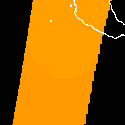Passive Microwave Product Details
EVALUATION PRODUCT DETAILS
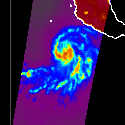
37 GHz Horizontal
For precipitation, used primarily for intensity and areal extent at lower levels in the atmosphere than the 89 GHz channel. The yellow and red colors over ocean indicate more intense rainfall (or islands).
EVALUATION PRODUCT DETAILS
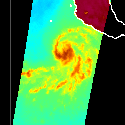
37 GHz Vertical
For precipitation, used primarily for intensity and areal extent at lower levels in the atmosphere than the 89 GHz channel. The yellow and red colors over ocean indicate more intense rainfall (or islands).
EVALUATION PRODUCT DETAILS
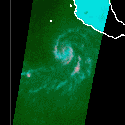
37 GHz RGB
The 37 GHz color composite combines the horizontal and vertical polarizations and the "PCT" calculation, a difference between the horizontal and vertically polarized brightness temperatures. The resulting color combination helps to discriminate areas of deep cloudiness (light blue) from more active convection (pink) and areas of open water (green) or land (cyan).
EVALUATION PRODUCT DETAILS
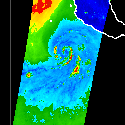
89 GHz Horizontal
For precipitation, used primarily for intensity and identifying storms with high ice content. The in-storm yellow and red colors over ocean indicate more in-cloud ice content.
EVALUATION PRODUCT DETAILS
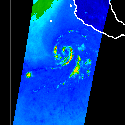
89 GHz Vertical
For precipitation, used primarily for intensity and identifying storms with high ice content. The in-storm yellow and red colors over ocean indicate more in-cloud ice content.
EVALUATION PRODUCT DETAILS
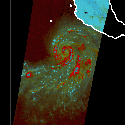
89 GHz RGB
The 89 GHz color composite is similar to the 37 GHz composite by combining the horizontal and vertical polarizations with the "PCT" difference product, but does an even better job of identifying areas of strong convection due to the characteristics of scattering of the 89 GHz by large ice particles. Areas of thunderstorms or deep cloud cover often show up as bright red. Note that although we characterize the composite as "89 GHz", the actual frequencies vary by instrument: 85 GHz for TRMM and SSM/I, and 91 GHz for the SSMI/S instruments.
EVALUATION PRODUCT DETAILS
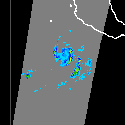
Rain Rate
A quantitative measure of the instantaneous rain intensity in in/hr or mm/hr. Use the color bar for the rain intensity vs. color relationship.


